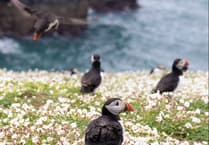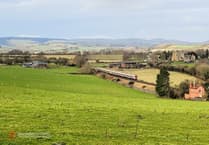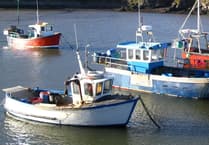Wednesday, October 18, was the centenary of the restoration of monastic life to Caldey Island. On that St. Luke's Day in 1906, Abbot Aelred Carlyle, who in 1895 had founded a community of Benedictine monks in the church of England, brought his community to Caldey for permanent settlement and to build the present monastery. They had spent a trial year on the island in 1901, but financial pressure had forced them to withdraw to Yorkshire. Therefore, when they came back to Caldey in October 1906, they called their return 'the Homecoming'. The building of the Caldey monastery, with John Coates Carter, of Penarth, as architect, was completed well before 1913. In that year, Abbot Aelred Carlyle and almost all his community were received into the Roman Catholic Church. Fifteen years later, further financial problems caused these now Catholic Benedictines to accept the bequest of a large house with surrounding land in Gloucestershire, and thus they moved to Prinknash Park, near Gloucester, at the end of 1928 to found their present abbey there. Caldey Island was then acquired by the Cistercian Order, well known in the history of Wales for its 13 pre-Reformation houses of monks, including Whitland Abbey and Tintern Abbey, and its two houses of nuns. At the beginning of 1929, Caldey was duly colonised by Cistercian monks from Chimay in Belgium, the forerunners of the present community. On Wednesday this week, the Abbot of Prinknash, Abbot Francis Baird, and Father Mark Hargreaves, former Abbot of Prinknash, were on Caldey to celebrate the centenary of their 'Homecoming', as guests of the present Cistercian Abbot of Caldey, Dom Daniel van Santvoort, and his monastic brethren. At the Mass of thanksgiving, Father Daniel, the Abbot of Caldey, was the preacher. Among those present was Father Hugh Randolph from Nunraw, the Cistercian monastery in Scotland, who was once a Benedictine novice at Prinknash and, much later, a Cistercian novice-master on Caldey. By a happy coincidence, a senior monk from another Benedictine house had asked quite independently to stay at Caldey this week, and so was able to join in the celebrations; he was Father Francis Rossiter, Prior of Ealing Abbey and at one time Abbot President of the English Benedictine Congregation. In the afternoon there was a social gathering in the Caldey Monastery Guesthouse, at which all the islanders could meet the visitors on this historic occasion. When monks returned to Caldey 100 years ago, there had been a gap of 370 years without any lasting monastic presence on the island. In 1141, the abbey of St. Dogmaels in Ceredigion, founded by Benedictine monks from Tiron in Normandy, had set up a dependent monastery on Caldey, now the ruined 'Old Priory'. But this was suppressed by King Henry VIII in 1536 with his Dissolution of the Monasteries. Much earlier, in the sixth century and after, there had been a Celtic monastery on Caldey, associated with Samson (later Bishop of Dol in Brittany), with Illtud, Dyfrig and other near-contemporaries of David and Teilo in the Age of the Saints.




